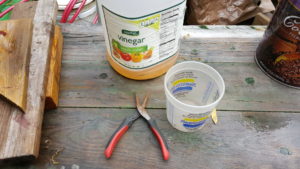I live in Michigan and work in an unheated shop. In the winter, when I use a space heater to work, condensation forms on metal surfaces and rust happens. I try to keep my tools oiled but once in a while I miss something. There is a real simple way to remove rust that is dirt cheap and very effective. In fact, you may even be surprised. Apple cider vinegar is a safe and easy way to remove rust. Note, it may well remove finishes such as bluing so you just want to do this on bare metals.
Apple cider vinegar contains acetic acid at a low concentration. All you need to do is let your tool, or whatever, sit in the cider while you do other work. In general, warmer is better. I’d shoot for 60-70F or it will take forever but I wouldn’t bother boiling the cider either. It was 62F when I fixed these needle nose pliers and it took about half an hour.
Be sure to do this outside or some place well ventilated. If you don’t, the vapors can cause rust. I do most of my work out in my drive way to avoid causing problems.
So, here are a decent but rusty pair of small Ace needle nose pliers with plenty of surface rust. All I needed to start was cheap apple cider vinegar (Spartan is a store brand here) and a small plastic container. The one caveat is that the pliers can’t have oil or grease on them so I did spray them with brake cleaner to remove any oils before the next step. You could use whatever cleaner or solvent you like.
So I just submerged the tool in the vinegar. I’ve used everything from wall paper tubs to cups to bowls and so forth. After a while you should see foam around the metal from tiny gas bubbles coming up and this means it is working. It may take 5-10 minutes before you see any bubbles because this is a slow reaction. If you never see bubbles then it may mean either there is oil on the metal, the remaining acetic acid is too weak (if you are re-using vinegar over and over the acid gets used up so there is less and less of it per given volume) or it is too cold. I would not bother doing this under 50F or it will take forever.
In this example, i was about 30 minutes before I pulled the pliers out. In general, the warmer the solution the faster it will react. It was 62F when I did these and I didn’t bother heating anything. Look at how foamy the rust looks and the steel has turned a grey color. The rust will come right off. I used 0000 steel wool to remove it. If the tool needed more time, I could dunk it back it. In my case, the tool was definitely done. I then hosed the tool down liberally with WD40 to remove the vinegar and avoid rusting. If you want to pour boiling water on it you can but you need to get something on there fast to prevent rust. In general, I just use WD40 followed by CLP or oil because the acid in the vinegar is so weak and I’ve not had a problem with rust later. If I was using a stronger acid, then I would be worrying more about neutralizing, then rinsing, applying WD40 and then oil.
Here’s what it looked like after I oiled it. After that, I just put it away – it was that easy! I do this a few times a year at least and the process has worked just fine.
When I was done, I put the vinegar back in a separate container to use again. If you want, you could throw it out. It will slowly weaken with repeated use. If I have any doubt about effectiveness, I toss the cider and use some that is fresh.
I keep this just in the garage and well away from the kitchen. The point is that you don’t want people consuming contaminated vinegar so label it and keep it away from the kitchen, pantry, etc.
If you find this post useful, please share the link on Facebook, with your friends, etc. Your support is much appreciated and if you have any feedback, please email me at in**@*********ps.com. Please note that for links to other websites, we are only paid if there is an affiliate program such as Avantlink, Impact, Amazon and eBay and only if you purchase something. If you’d like to directly contribute towards our continued reporting, please visit our funding page.







